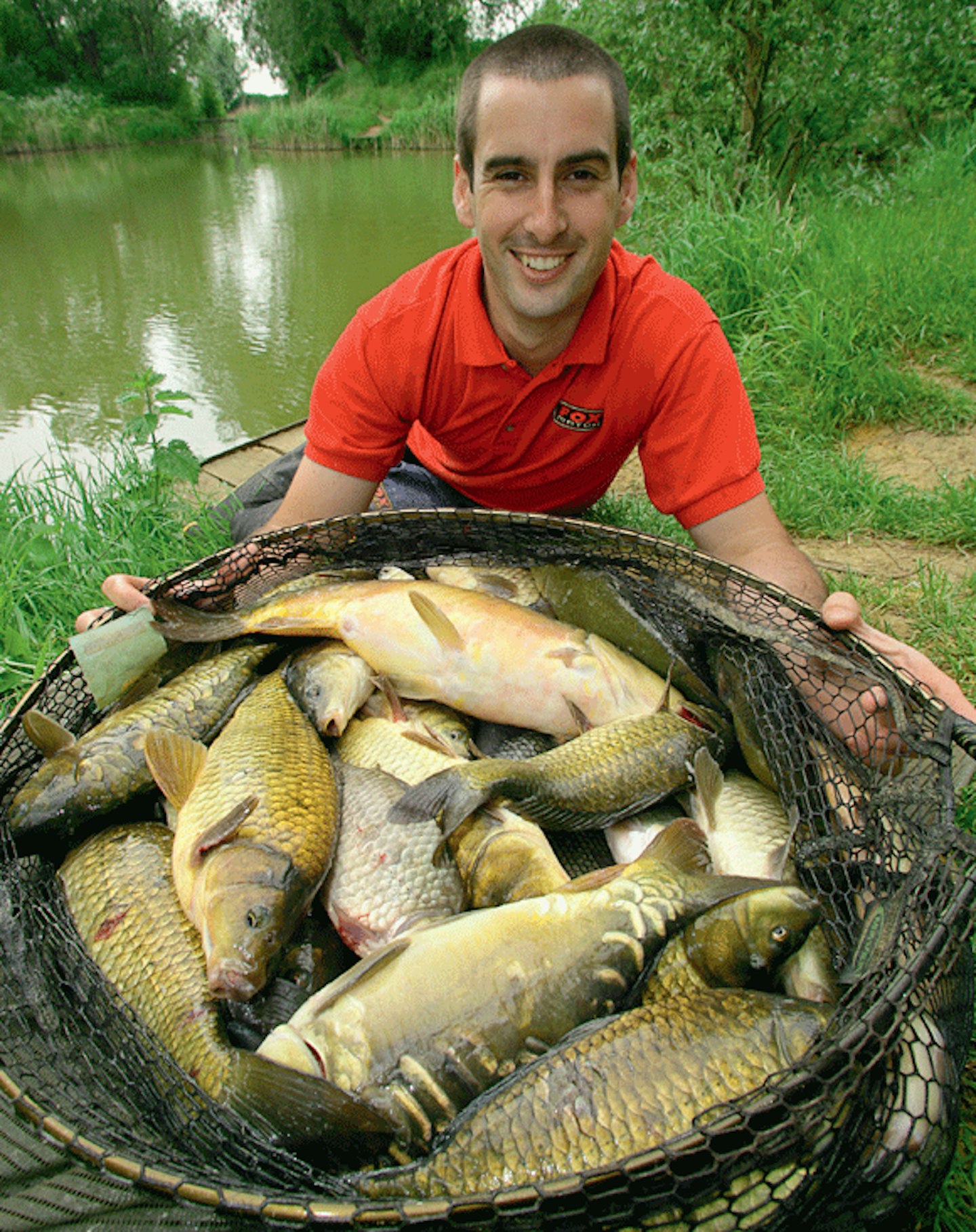Catmeat is one of the most effective summer commercial carp baits. Everything that we anglers dislike about catfood – the smell, the mess, greasy and oily texture – is absolutely adored by fish. Especially carp.
Add this to the fact that catmeat comes prepackaged in fantastic carp-attracting flavours like pilchard, tuna, salmon and sardine, and it’s easy to see why it is such devastating bait.
Another advantage of catmeat is its soft texture, something else that carp go for. And another plus point to this underused bait is that it’s super cheap, generally costing between 30p and 40p per tin.
To witness the power of catmeat, we joined Steve Cole, on the banks of Decoy Lakes, near Whittlesey, Cambridgeshire for a lesson in how to most effectively use it.
Steve takes a unique approach to his catmeat fishing by using it in three different ways on the same day. This allows him to target several areas with slightly different tactics from the comfort of one peg and pretty much guarantees that he’ll take rakes of fish from all areas within one five-hour session.
We set up on Decoy’s popular Willow Lake for a masterclass in catmeat fishing that you’ll find really easy to follow and copy.
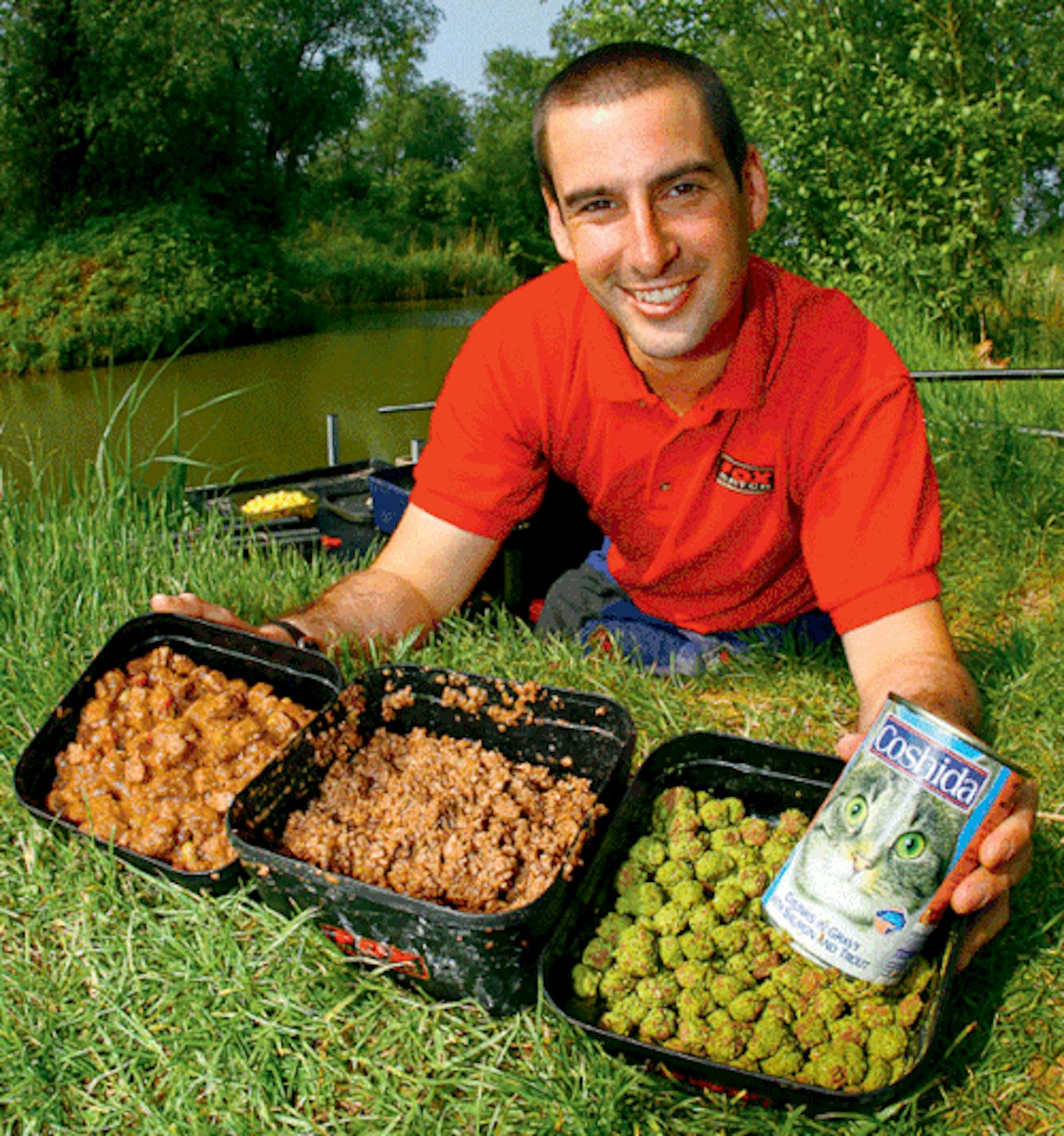
Here's how Steve fishes this deadly commercial carp bait using pole tactics...
Why use catmeat?
Love it or loath it, no angler can argue about the magical fish-pulling spell catmeat seems to cast over carp. The fact that it is such an oily, slimy, rancid bait for us to handle, is its main attraction for the fish. Being meat, it is packed with protein, ideal for when carp are heavily on the feed.
Add to this all manner of different flavours – some anglers preferring the meaty varieties like heart and beef, while others place their faith in the fishy varieties – it is second to none when it comes to targeting highly-stocked commercial venue carp.
But with so many different meats on the market, it can be confusing to know which one(s) to choose.
“The cheap stuff is what I always go for,” Steve told us.
“Also, always use catmeat chunks in gravy, rather than the solid meat products.
“The great thing from an angling perspective is that the really cheap stuff is probably best. The one I use comes from the supermarket Lidl, either Coshida or Opticat which cost about 30 pence a tin.”
Unfortunately, there are a couple of drawbacks with using catmeat.
The first one is that it is a seasonal bait. Being a high protein food, it can only really be used when the carp are hard on the feed, usually between mid-May through to mid- September.
Steve revealed that he had used it in the colder months but you have to fish it on the right days and be very sparing with the amount of free offerings you put in. The second drawback is that it is banned on some commercial fisheries.
“In my opinion, catmeat has received some bad press over the years, leading to it to be banned on some fisheries where owners have deemed that it damages the fish,” Steve added.
“The trouble has been a minority of anglers piling in two dozen tins or more at a time and this has ruined it for the more sensible anglers among us. Two or three tins are more than enough for a session.
“Furthermore, I think if it is good enough to feed pampered cats, then it should be fine for carp, too.
“Also, I’m fishing today at Decoy Lakes – one of the countries premier match and pleasure complexes. The owners of this venue don’t ban catmeat and their fish stocks are healthy and the catch rates remain prolific – some of the highest in the country, in fact.”
How to prepare the catmeat slop
To prepare catmeat slop, simply push the lot through a fine mesh riddle. It can then be fed into the swim using a small Fox Toss Pot or pole cup attached to the end of the pole’s top-three section. The beauty of this is that you can be 100 per cent accurate.
The slop, once in the water, creates a lovely oily, greasy cloud of smell and attraction, but with nothing solid for the carp to feed on – apart from your hookbait.
The thing to avoid when using slop is not to use it in water that is deeper than three foot as the cloud will disperse too wide and the tactic will lose its effectiveness.
“When it comes to using the slop, always have a tub of water next to you because if you don’t wash your fingers after handling it, catmeat gets everywhere” Steve warned.
“Also, there are a number of different liquid additives on the market like Liquid Catmeat. These may make a difference, but I don’t see the point in using them – it’s gilding the lily.”

STEP ONE
Empty a whole tin of catmeat on to a fine mesh riddle.
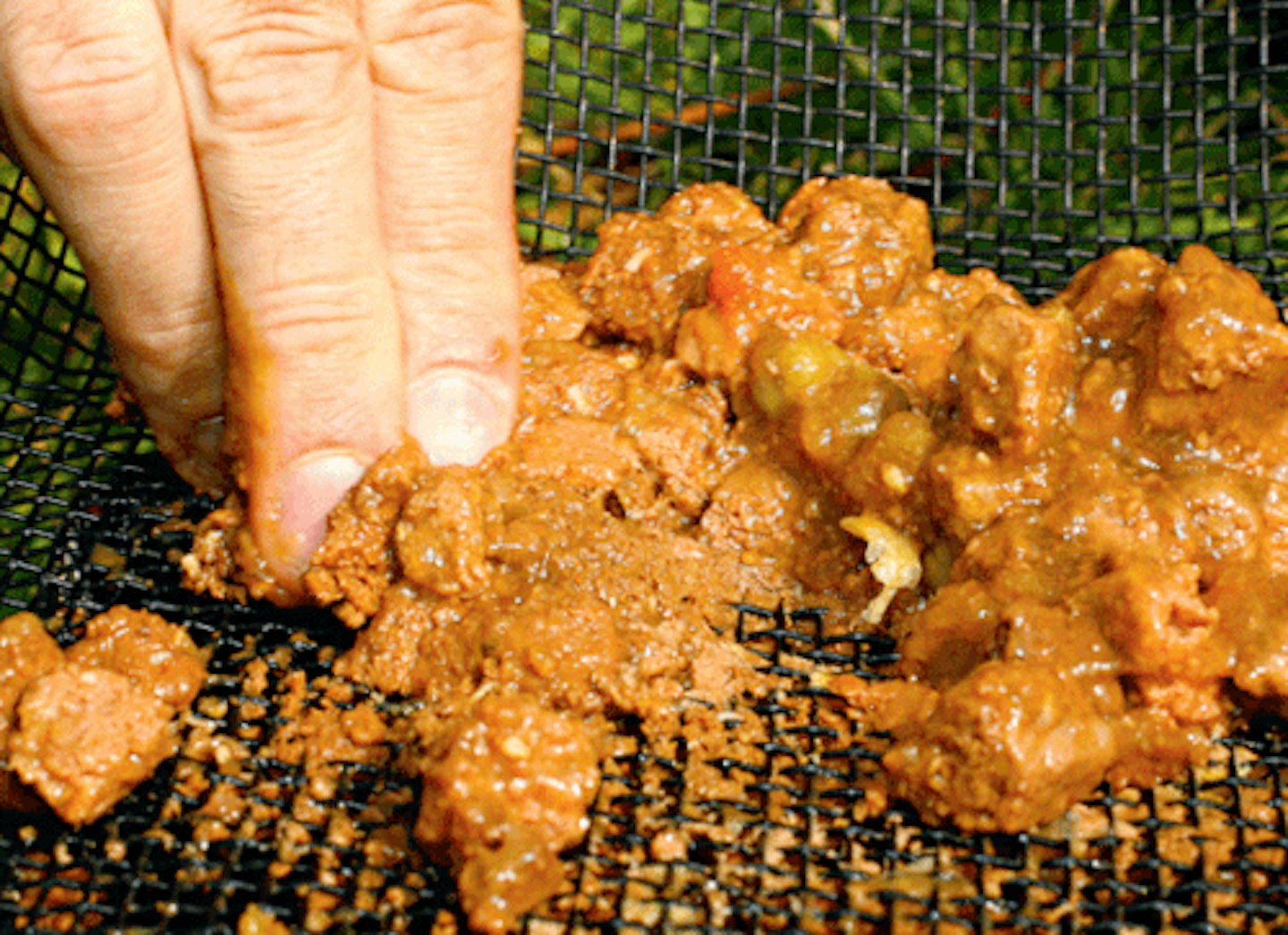
STEP TWO
Push all the contents through the mesh of the riddle.
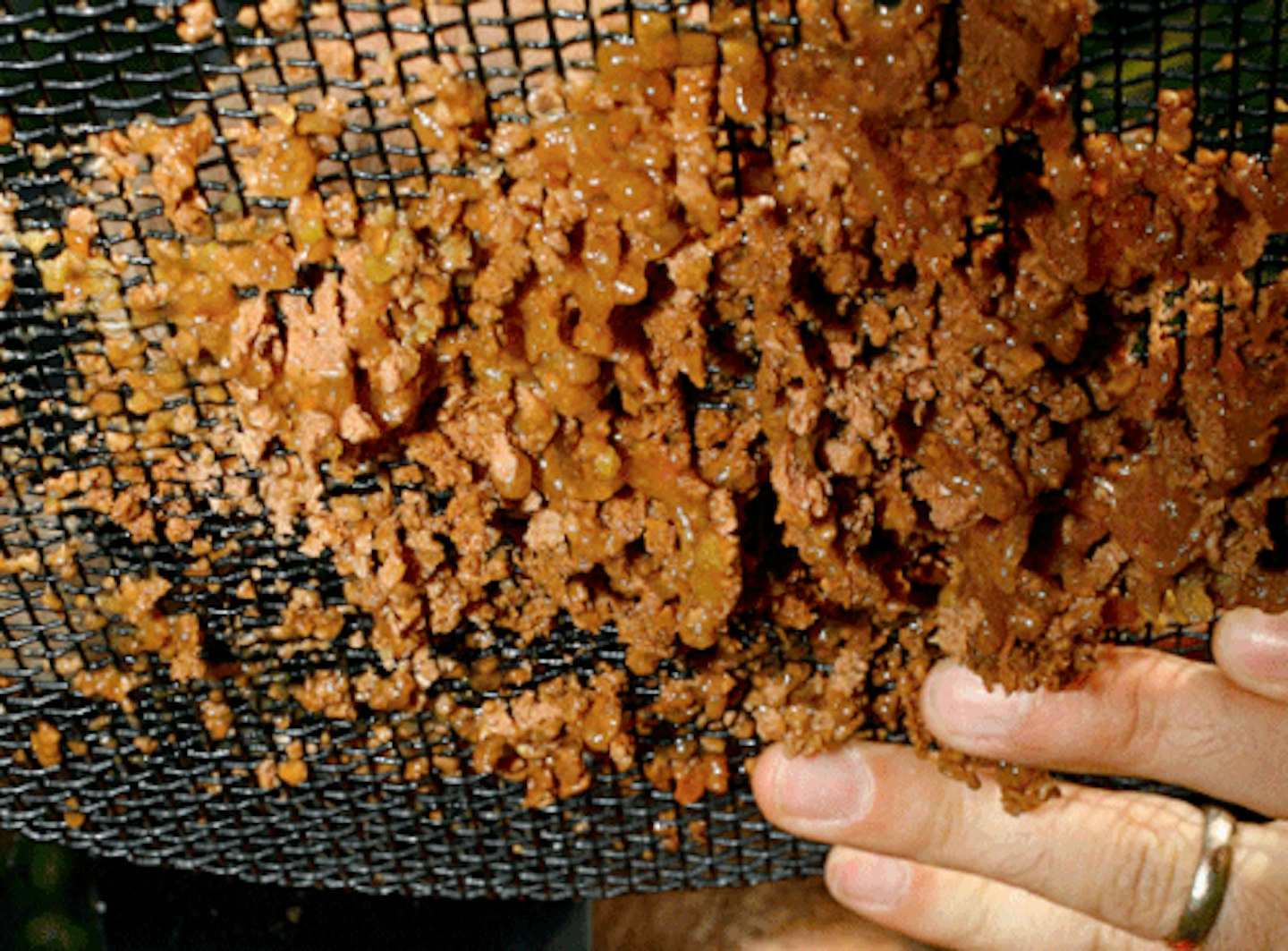
STEP THREE
Lots of it will stick to the bottom of the riddle, so just wipe it in to your bait tub.
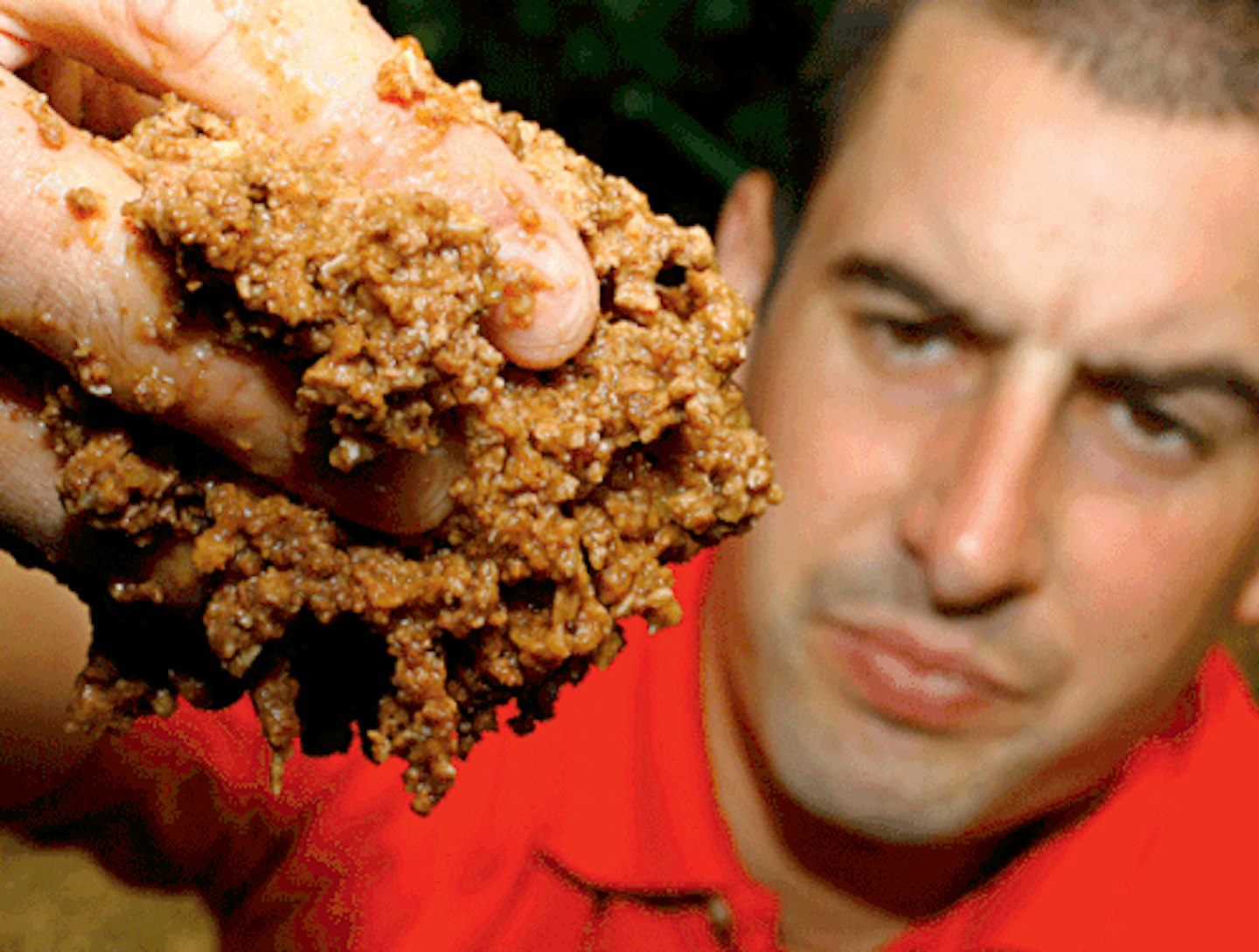
STEP FOUR
The finished product is a fine, oily and meaty goo that fish adore.
Preparing the hookbait
Although there is simply nothing wrong with using the chunks of catmeat straight from the can, there's always something an angler can do to 'pep-up' the bait to make it even more appealing to carp. And also to make the bait stand out from the feed. And also to put you ahead of the angler on the next peg.
Steve utilises Dynamite Baits Green Swim Stim groundbait to give his catmeat chunks a coating that provides even more attraction.
Here's how it's done...
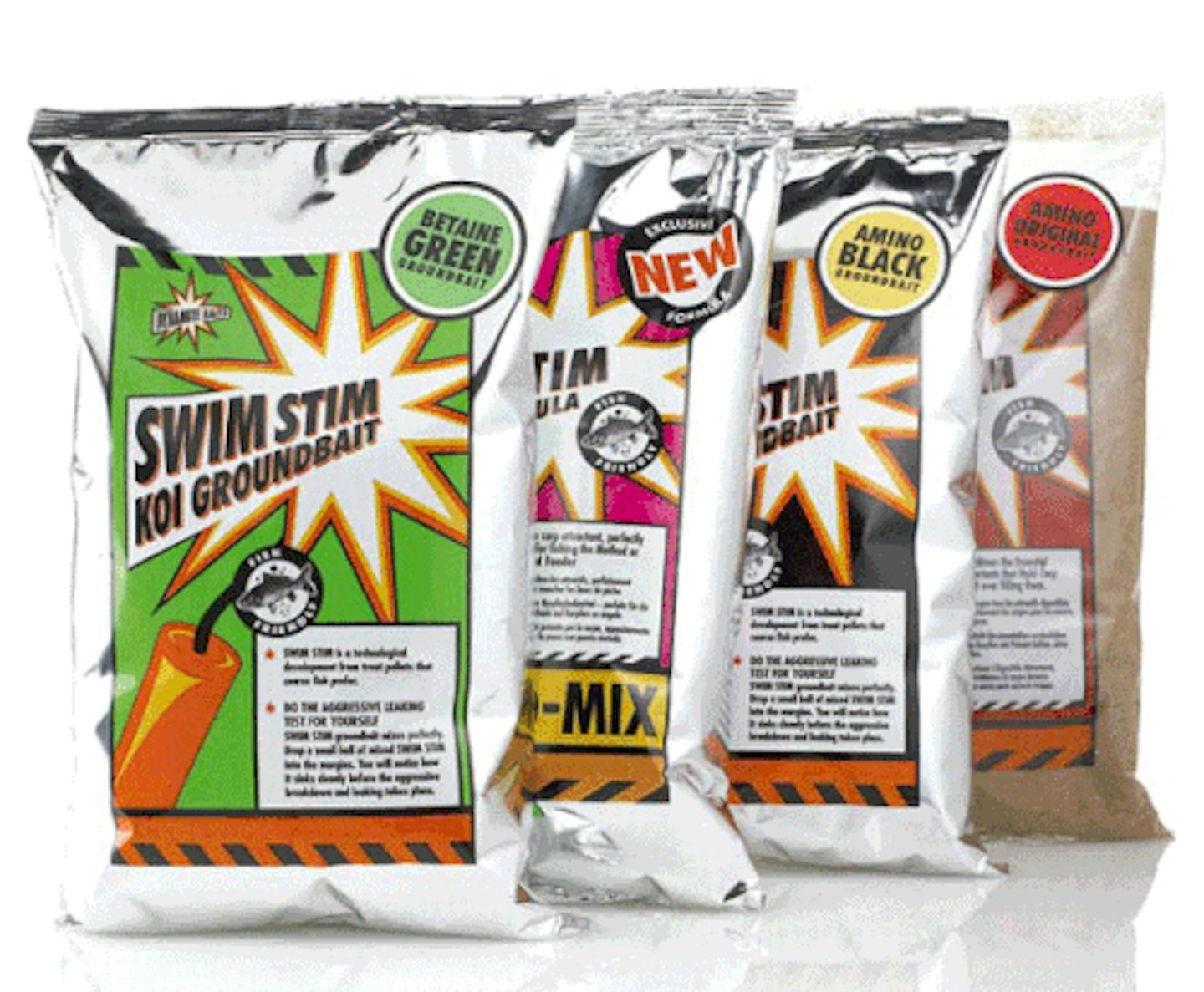
STEP ONE
After washing off the catmeat, by tipping it onto a riddle and rinsing, you'll be left with clean chunks of meat. Now take a bag of Dynamite Baits Green Swim Stim and sprinkle the crumb over the top.

STEP TWO
Very carefully push the chunks of meat around in the groundbait to ensure that each piece gets a good coating of the green fishmeal groundbait.
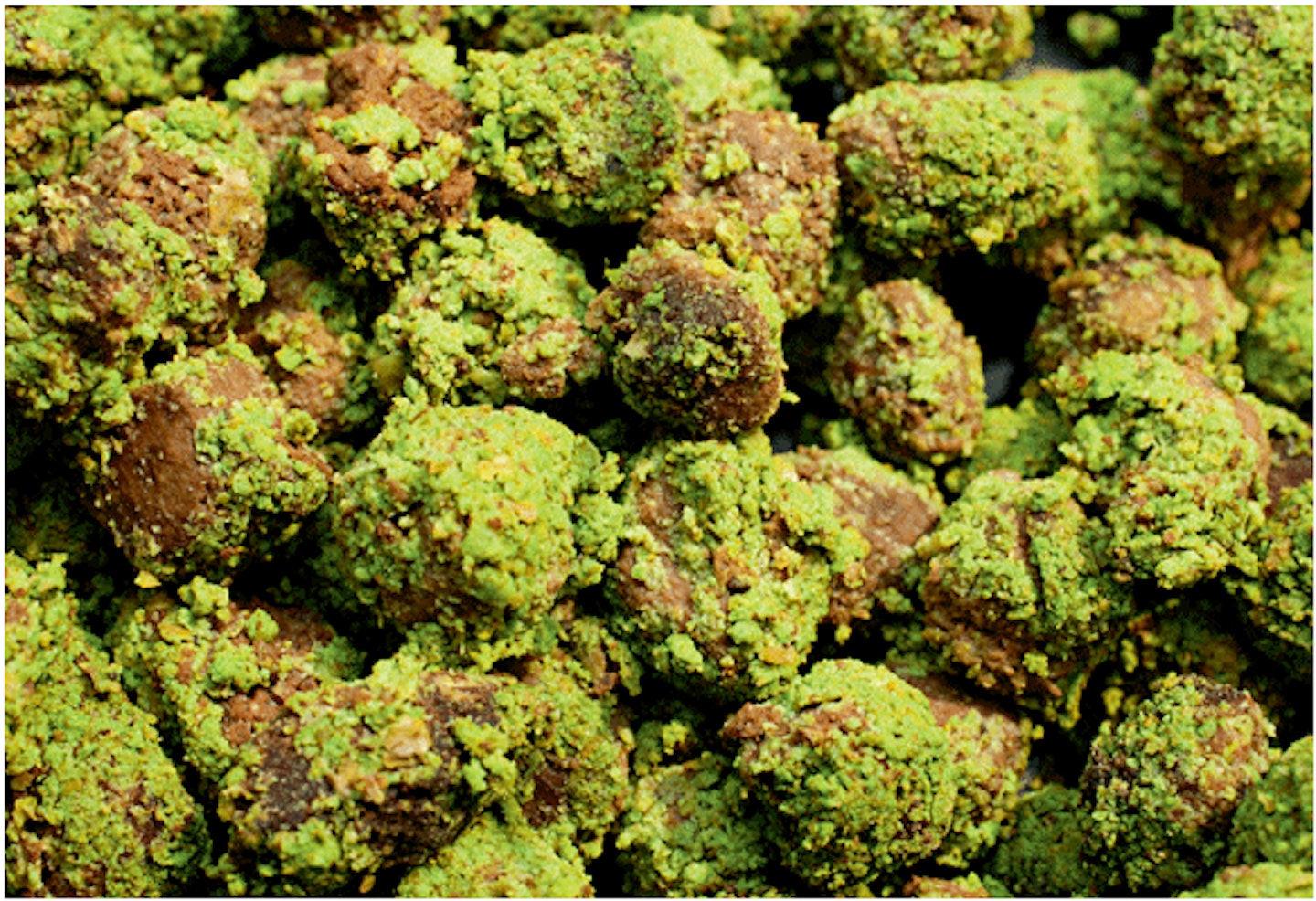
STEP THREE
The groundbait sticks to the meaty chunks to not only provide an extra scent trail, but it also forms a tougher outer layer which helps it stay on the hook at range.
SWIM ONE
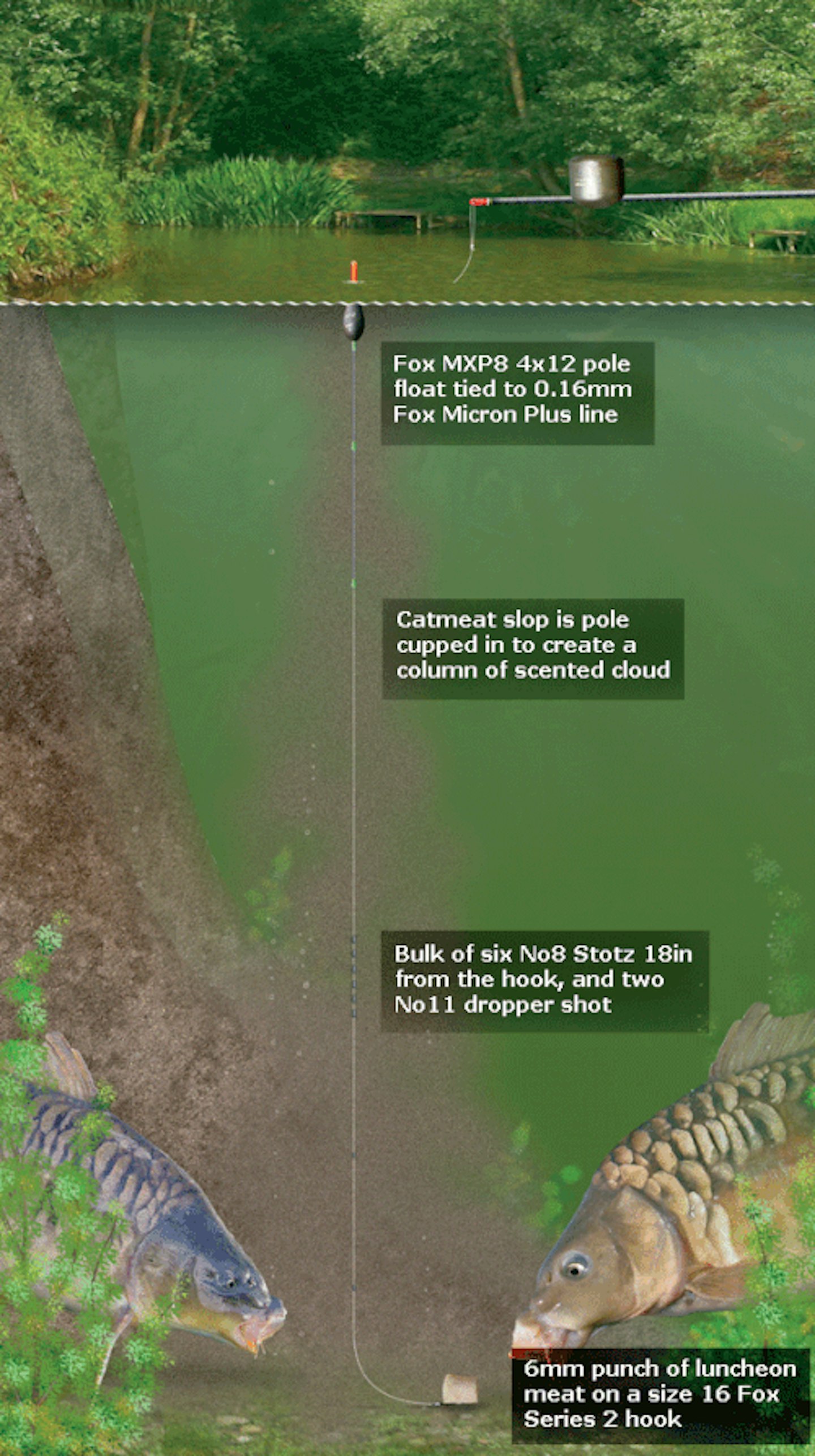
Island margins
The first of Steve’s three-swim approach involved fishing up to the margins of Willow’s island.
Carp regularly patrol these features as at this time of year to be in the warmer, shallow water.
The trouble is that they go round and round, so it is up to the angler to stop them, forcing them to feed.
With most commercial islands being nine to 16 metres away, many people just fish sweetcorn or pellets because catmeat is so soft it is hard work to fish at distance. But to force patrolling carp to feed, Steve uses catmeat slop.
“Carp usually see pellet after pellet, but they’ll leap on catmeat, because it’s different. This is why it’s effective against far-off features.”
Kick off and feed
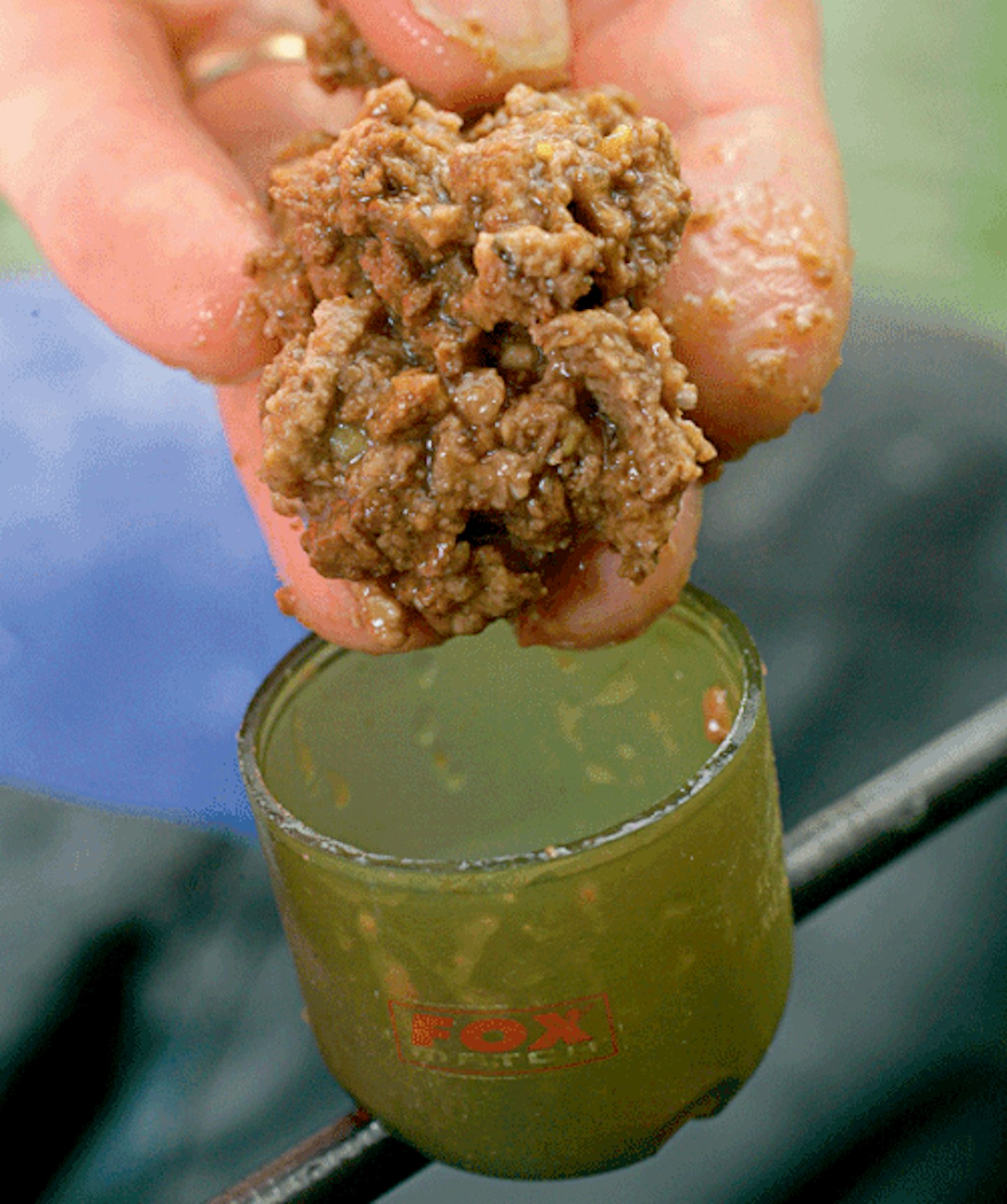
Once the slop is prepared, Steve fishes it through a Toss Pot because he’s aiming to build the swim slowly, rather than piling in a load of bait at the start.
By priming the swim with a large pole cup, you bring too many fish into the swim which will result in a lot of foul hooking, ruining the swim before you’ve even started.
With a smaller Toss Pot, Steve can feed, put his bait over the top – in this case the hookbait is a 6mm punch of plain luncheon meat – catch a fish and then repeat the process. This has the effect of slowly building the swim. The more bites he gets, the more bait goes in, the more the swim builds. If he doesn’t get a bite within four or five minutes, only then will he pot in another Toss Pot full of slop.
“You still need bait going through the water, just not too much at once, because the swim will be full of fish and it will be total chaos with fish racing all over the swim,” Steve said.
“By adding slop little and often, you keep greater control over what is happening beneath the surface.
“You can only catch one fish at a time, so why have the swim crawling with loads of carp? All you get is lots of foul hooking which then spooks the fish.”
The hookbait Steve uses on his long island line is either punches of luncheon meat or, occasionally, sweetcorn. These baits are more robust than cubes of softer catmeat so they’re easier to fish at distance, staying on the hook better.
SWIM TWO
Open water
When targeting his open water swim, Steve starts by finding the average depth of the water – generally three to eight foot on most commercial pools.
As well as fishing to the island, Steve plumbs up an area 45 degrees to the left of his island swim. This keeps his second swim away from the first.
Also, if he fishes in line with the island in his open water swim, every fish that is hooked near the island will be played through this second swim. This will spook any fish feeding in this area.
By keeping the second swim on a different line, he can get the carp feeding confidently in both areas.
When fishing in open water, Steve will feed catmeat straight out of the tin then fish ‘dusted’ catmeat over the top. Dusted meat involves washing off any gravy and sludge from the tinned meat then covering it with a sprinkling of dry groundbait.
Steve uses Dynamite Baits Green Swim Stim but any groundbait will work as long as it has a fine consistency so that it will stick to the meat.
“The groundbait creates an outer shell, toughening the meat,” Steve said.
“This process allows me to fish this soft bait at longer lengths, like today where I’m fishing at nine metres.”
The other beauty of creating a groundbait jacket is that there is a little more attraction coming off the catmeat as the groundbait breaks down.
To kick off this open area, Steve feeds a full pole cup of plain catmeat then leaves the swim to rest for an hour. After this hour he’ll fish for five minutes. If there are no carp forthcoming, he feeds the same again then leaves the swim for 30 minutes before trying again.
“The reason for leaving it an hour is so the fish in open water gain confidence,” he said.
“I’m looking for a fish straight away. If there are no bites, feed and look again in half-an-hour, just in case the fish are coming in, eating and leaving.”
SWIM THREE
The margins
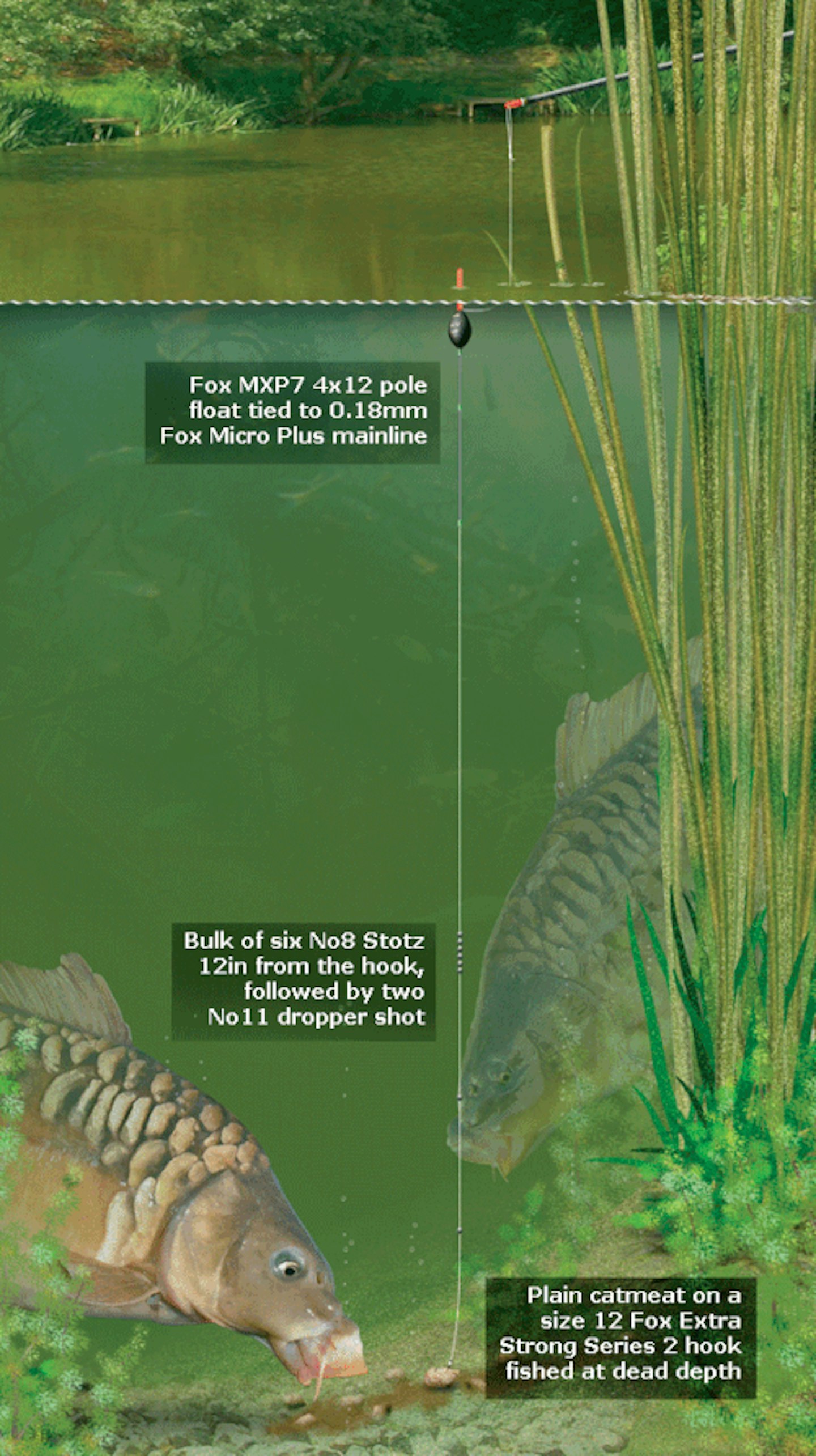
Steve’s final swim of the day is in the margins. He targets this area only in the last hour of the session and doesn’t feed it at all until he is ready to fish there.
“The reason I wait till the last hour to feed and fish is that I’m trying to replicate an angler leaving for the day and throwing all their left over bait in,” Steve explained.
“The big wary fish know that later in the day these areas are safe and that they can get free food.”
To imitate a departing angler, Steve cups in three full pots of plain meat – gravy and all. He also cups it in from a height to resemble food that’s being thrown in. He will then spend the entire last hour fishing on this line when he could catch up to 50lb or more!
“I always use straight meat rather than slop in the margins as it is better for attracting larger fish,” Steve said.
“Over the top I fish a single chunk of plain meat to resemble the rest of the freebies.”
If bites dry up for 10 minutes, he’ll cup another full pot straight in.

The session
Starting the day against the island with his foul-smelling catmeat slop, Steve very quickly had his swim fizzing and bubbling as the fish drove themselves into a feeding frenzy.
A 6mm punch of luncheon meat on his hook kept bites from carp and F1s coming very steadily through the next hour.
Then it was time for Steve to look in open water. With no bites after five minutes, it was in with another pot of meat and back to the island.
After four hours, Steve was taking fish with frightening regularity from the island swim.
He’d also had a couple of large carp from open water to boost his already impressive catch. With only an hour left, it was into the margins.
Following his own advice, Steve scattered four large pots of catmeat next to a clump of reeds, before following this up with his margin rig.
Within seconds the fl oat buried and he was into a good carp, which tipped the scales to around 6lb.
By the end of his five-hour session each of Steve’s three swims had produced more than 40lb of fighting-fit carp and F1s.
He managed to keep three swims going with essentially the same bait. But by applying a little thought Steve had shown three very different uses for catmeat.
Although he used three different presentations on the day, Steve’s approach is by no means exclusive to catmeat. By thinking outside the box you too could add spice to a bait you probably thought could only be fished one way
